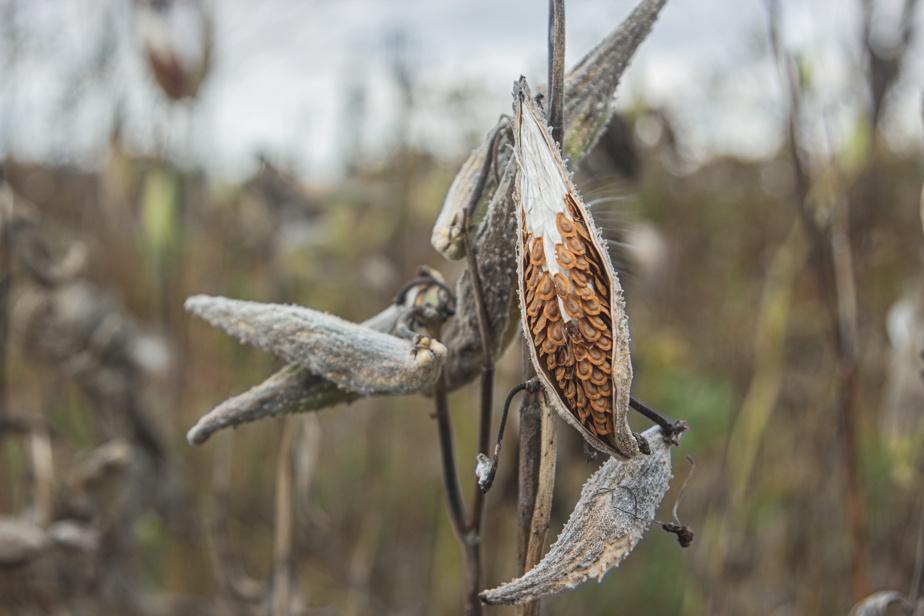
The timid return of milkweed
On attendait beaucoup de l’asclépiade, une fibre superbement isolante, légère et hydrophobe. On a bien vu la société québécoise Quartz Co. offrir des manteaux de ville haut de gamme. Et puis, plus rien. Les entreprises impliquées dans la production de cet isolant ont abandonné la partie ou ont carrément fait faillite, et l’asclépiade a disparu des écrans radars.
But now small businesses have discreetly taken over the torch and are concocting clothing that might appeal to outdoor enthusiasts. Lasclay relies on mittens padded with pure milkweed as Atypical Equipment completes the design of isolated coats and jackets with a mixture of milkweed, kapok and PLA (polylactic acid), a bioplastic synthesized from corn starch.
"during my baccalaureate, I was very attracted to entrepreneurship," says Atypic founder Antoine Bolduc. One day, I discovered milkweed, its history with chlorophyll, quartz and other actors in the environment. I've seen his potential in the outdoor field. I myself love nature, especially in Quebec. I wanted to be able to use milkweed in my own activities. "
A treasure weed
Milkweed is a plant that has long been considered a weed. However, a few years ago, it was realized that the silky fibres in his pod have insulating and hydrophobic properties. A small industry has been set up to market this product. But the company at the centre of this movement, Protec-Style, went bankrupt in 2017 and the industry broke up.
"in part, this is due to the fact that it started too big: we already saw each other as the new Gore-Tex," says Gabriel Gouveia, co-founder of Lasclay. It was a very commendable approach, but we have a different approach: we are leaving small. "

Lasclay chose a very simple, relatively inexpensive product: the glove. "in Quebec, there are a lot of people who are cold and willing to pay a price for not being cold anymore," says Mr. Gouveia. For us, this is an opportunity to make as many people as possible aware of the benefits of milkweed and to make them addicted. "
Because it is a small product, it is possible to make a "fairly substantial" production in a small workshop, located in Beauport.?
Lasclay differs in another way. The early users of milkweed chose to integrate the milkweed into a kind of membrane. "this is the way in the textile industry," says Gouveia. The problem is, it takes to dilute the milkweed, to mix it with something else. The other problem is that when you cut off irregular shapes, like round mittens, you get a loss of up to 30%. "
Lasclay therefore decided to padding his mittens directly with milkweed, but still to do a small quilting to keep the fibre in place.
Search for solutions
The padding of larger pieces of clothing would, however, be more problematic. Thus, small companies, such as Eko-Terre, which is still extremely discreet in its plans, and Atypic have chosen the membrane technique.
Kapok and corn starch have almost the same properties as milkweed, but these fibres are easier to handle and less volatile. It solves the insulation, it allows us to make production easier and reduce costs.
Antoine Bolduc, founder of Atypic
Despite all its qualities, milkweed has a great flaw: fine dust that infiltrates everywhere, especially in machinery. "you can easily lose control and have too much dust," says Bolduc. This is the reason why companies no longer wanted to work with people in the milkweed industry: the dust made it impossible to give the employees good conditions. "
Milkweed is a very capricious fiber, he argues. "it is a very fragile product, it has to be treated almost artisanal in order to be able to use it. "
Atypic and Lasclay are each working on extraction processes that reduce dust.
Lasclay is now in its second year of production. Last year, she made 1,000 pairs of mittens. This year, it targets 1,500 to 2,000 pairs. She only offers her mittens online, especially to keep the price of the product as low as possible. In the shop, this price would have to be significantly increased to take account of the retailer's profit margin.
"we're trying to democratize milkweed, but it's still a high-end product," says Gouveia. "
For its part, Atypical provided funding through Kickstarter to start operations, and in less than 24 hours the small business raised $30,000. "it made it possible to finalize the purchase of the raw material, to pay the salaries and to start production," says Antoine Bolduc.
A loss for climbing
This young man on a 1959 television show could have become a great climber. He became a musician.
Number of the week
325 000
This is the estimated number of white-tailed deer in Quebec.







